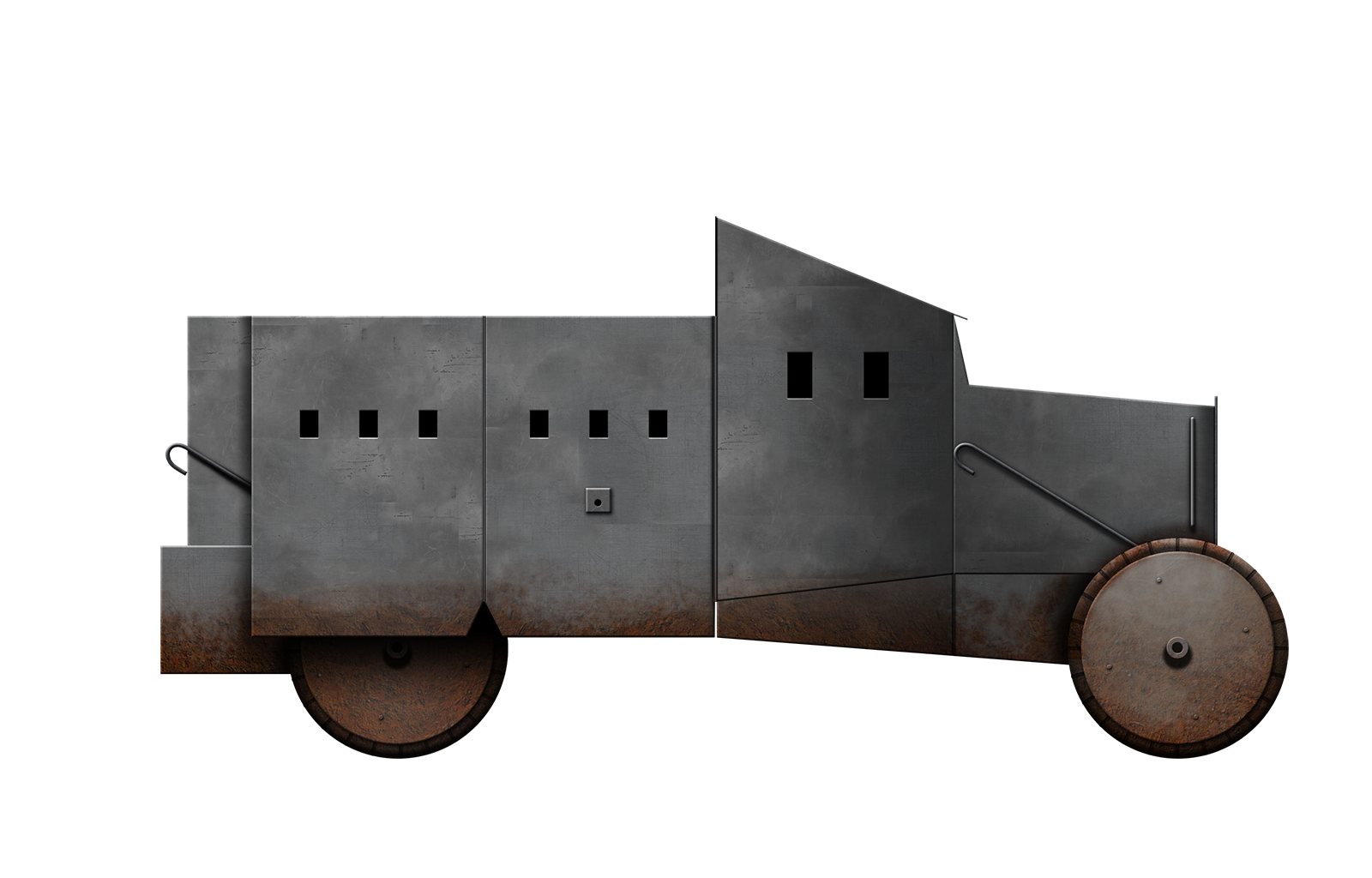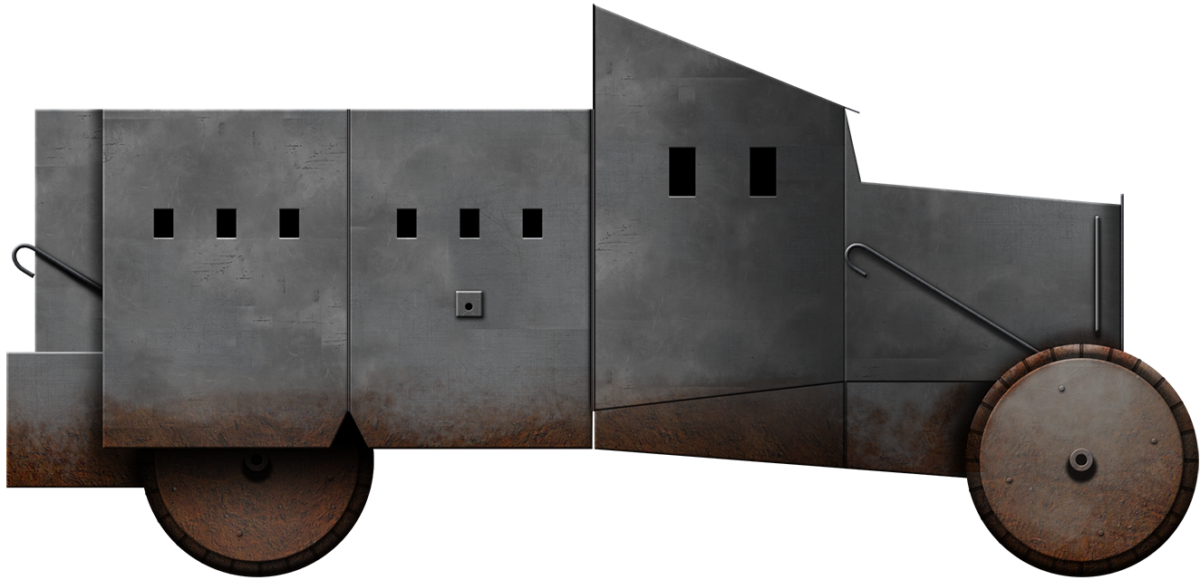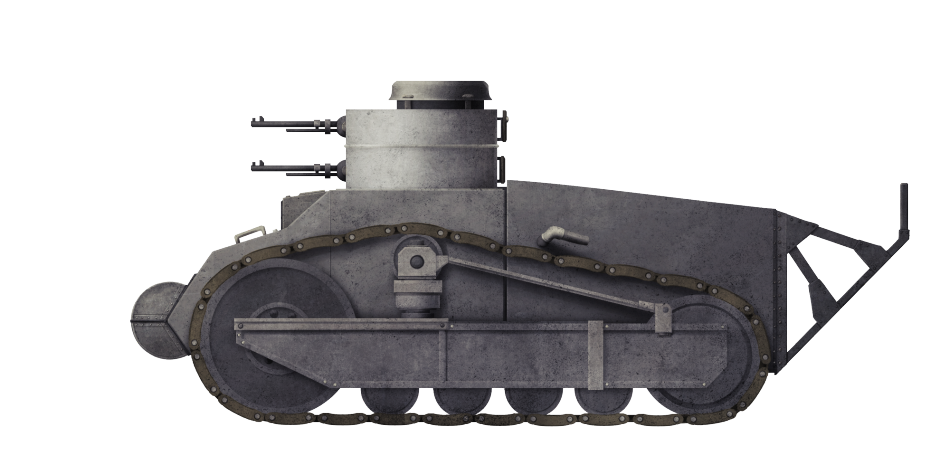 Kingdom of Spain (1921-1922)
Kingdom of Spain (1921-1922)
Armored Car – 1 or 2 Built
In terms of armored vehicles resulting from both public and private ventures, the years following the Great War saw major developments. This was even true for those not embroiled in conflict, as was the case of the Kingdom of Spain. One of the vehicles to emerge from this period was the Blindado Romeo designed and funded by the Spanish journalist and parliamentarian Leopoldo Romeo in 1921. The vehicle was envisioned to be used in North Africa in the colonial war Spain was fighting and losing there.
Context – Disaster in the Rif
With the loss of its other overseas colonies in 1898, North Africa had become the focal point for Spanish military expeditions and it created the opportunity for career military officers to progress up the ranks. The initial expansion in the Rif area of Morocco, a mountainous region in the north along the coast of the Mediterranean Sea, was slow and peaceful. However, by 1909, Rif tribesmen had begun to ambush Spanish rail workers and settlers. To stop the Rifians who operated over the vastness of the mostly inhabited Rif, the Spanish turned to the new weapon of war, the armored car. Just before the beginning of the war in Europe, Spain had been one of the pioneering states in the use of armored vehicles in military conflicts, with the use of the French-built Schneider-Brillié.
In the summer of 1921, General Manuel Fernández Silvestre, without first securing his rear, led his troops far into enemy-controlled territory until they arrived at the village of Annual. Here, on July 22nd, they met a superior force of Rif fighters under Abd el-Krim. Facing these odds, Silvestre then ordered a month-long retreat to Melilla, 120 km away, during which Silvestre’s forces were constantly ambushed and 14,000 men, including Silvestre (he allegedly committed suicide), died. Furthermore, 14,000 rifles, 1,000 machine guns, and 115 cannons were lost. Shortly afterwards, the Republic of the Rif was created.
Arming the Troops
Despite having a large land army, the Spanish forces in Morocco were not equipped to fight a modern war. The main aim was to acquire a number of the relatively new weapons of war – tanks. In the end, 10 machine gun armed Renault FTs and 6 Schneider CA-1s were bought from France and deployed to the Rif.
Additionally, a number of armored cars were developed in Spain to be sent to North Africa. These included the Blindado Landa and the far more successful series of Camiones Protegidos Modelo 1921.
A lesser-known armored car of this period was the Blindado Romeo. This vehicle was financed, designed and produced by Leopoldo Romeo y Sanz and was presented for the first time on August 22nd 1921.

Who Was Leopoldo Romeo?
The history of Leopoldo Romeo, also known as ‘Juán de Aragón’, is as interesting as that of the vehicle he created. Born on November 15th 1870 in Zaragoza, he did a degree in Law, Philosophy and Humanities in his local university. He dedicated most of his life to journalism, becoming an editor at Ranocés shortly after leaving university. He then moved to El Evangelio before becoming chief editor at the prestigious La Correspondencia de España in 1902. He also served as Spanish correspondent for the French newspaper Le Temps and the British Daily Telegraph. For the latter, he covered the Second Hague Conference of 1907 and the Spanish war in Melilla before the outbreak of the Great War. Based on these experiences, he developed a moralistic, anti-militaristic approach which landed him in prison in Madrid in 1909. It is somewhat ironic that, eleven years later, he would design a vehicle of war.

Leopoldo Romeo was also a politician, first being elected as a member for Santa Cruz de Tenerife in the Canary Islands in 1905. At the time, his profession was listed as lawyer. In 1907, he returned to his main role as a journalist before returning to politics as a member for his native Zaragoza in 1910. He returned as a member of the Spanish Parliament in the 1914, 1916, 1918, 1919, 1920, and 1923 elections representing Belchite, in the province of Zaragoza. Initially an Independent Liberal, by the 1914 election, he was a representative of the Partido Liberal [Eng. Liberal Party], one of Spain’s two largest parties, which alternated power in a system known as ‘turnismo‘ [Eng. taking turns]. He was considered to be part of the most liberal wing of the party and had a great friendship with Álvaro Figueroa y Torres, the Conde de Romanones, leader of the Partido Liberal between 1913 and 1918 and Prime Minister of Spain in 1912. Due to his friendship with Romanones, Romeo was appointed as Civil Governor of Madrid, the capital. During his time in the role, he had to deal with workers’ movements in Madrid during a period known as ‘el trienio Bolchevique’ [Eng. the three Bolshevik years].
Romeo died of pneumonia on March 26th 1925, four years after his military invention and with the war in the Rif still ongoing.

Design
As with many Spanish armored wheeled designs of the time, the Blindado Romeo was not an armored car in the conventional sense, but rather an armored transport vehicle, most of its offensive power being offered by the infantry it carried. In its essence, the ‘Blindado’ (Spanish for ‘armored’) was a car with an armored cover meant to withstand enemy rifle fire.
Chassis and Engine
There is some confusion over the chassis of the vehicle. Spanish military authors Francisco Marín Gutiérrez and José Mª Mata Duaso, the only ones to have covered the Blindado Romeo, point towards a Spanish Landa Landaulette 1920 automobile as the basis for the chassis of the vehicle. They claim the vehicle had a gasoline 4 cylinder 15 hp engine. They also state that the vehicle had right-hand drive.
There is not much information about the vehicles produced by the Spanish manufacturer Landa, but, based on the available information, some of Marín Gutiérrez and Mata Duaso’s claims seem questionable. Landaulette is an alternative spelling of Landaulet, which is a car body style where the rear passengers are covered by a convertible top, a popular design at the time. Landaulette may just be the style of the car rather than the type or model, and Landa are known to have produced landaulets at that time. Landa had a limited number of chassis designs, but advertised itself as producing any car body style upon request.
Photographic evidence demonstrates that the vehicle had left-hand drive though. Up until 1921, Landa had produced a number of cars with 2 cylinder engines manufactured by the same company and producing a maximum of 9 hp. Curiously, these had right-hand drive. Although today Spain drives on the right, until 1924, the city of Madrid drove on the left. In 1921, Landa moved to using the more powerful American 4 cylinder 15/35 hp Lycoming engines, which were positioned at the front.
Regardless, even with a meager maximum of 7 mm of all-round armor, which would have probably added around 2 tonnes, the weight would have proven too much for a chassis designed for an automobile. Similarly, the engine would have been underpowered.


Armor
One of the distinctive, though by no means unique, features of the vehicle was its armor. The armor itself was far from impressive, probably around 5 to 7 mm thick and made from chromium-nickel steel, more simply known as stainless steel, but considering the period and the opposition it would have faced, it was most likely sufficient. The entire vehicle was armored, including the wheels, with the tires being made from solid rubber. The sides of the vehicle though could be open like a parapet. At its maximum extension using both sides, this extended to 5 m in width.

To remain in position, the armored parapets had to be fixed in position in several parts. On their furthest extents to the sides, they were fixed into the ground with a latch. There were four metallic bars (two on each side) that attached the folding doors to the body of the vehicle near the rear wheels.
The idea is that one of these vehicles could provide enough cover for a squad of infantry soldiers from their shins upwards. Using several, these could provide cover for bigger units of infantry or even artillery pieces. However, for several reasons, it was a flawed design for its intended purpose. To pick up the metal bars at the front of the vehicle, a crewmember or a soldier would have had to expose themselves to enemy fire. Whilst the armor protection was enough to withstand anything that would be found in the Rif, the sides and rear were vulnerable and the parapets could only be deployed statically. In spite of his awards and being an excellent journalist, Leopoldo Romeo had not understood what kind of war was being fought in the Rif. The Spanish had continuously lost to Abd el-Krim because his forces outmaneuvered them, thus a static vehicle would have been of very limited use in open warfare. Had the vehicle been intended for urban policing, which was something very common in Spain at the time, its design would have been of more use. Deploying the parapets, one vehicle could block a whole street. Even today’s riot control vehicles use a very similar system.

Crew and Armament
The vehicle could have been operated by just one crew member, fulfilling the roles of driver and commander. Given the space at the front, it is likely that the vehicle would have had an actual commander in addition to the driver. The rear of the vehicle could have carried a maximum of four soldiers, who would have most likely sat on benches.
From the inside, the commander and driver had two slits in front of them and two each on the sides of the vehicle. These would have mainly been used to see their surroundings, but also probably to fire from, especially when the vehicle was static. The foldable parapet side armor had three slits for each panel, as did the rearmost side armor. The rear of the vehicle also had two slits. From the photographic evidence, it seems that these slits could have had a protective cover. This would suggest that the vehicle was also designed for the infantry complement to fire from the interior when in motion. Contemporary sources (Mundo Gráfico) suggest that inside the vehicle, two machine guns could have been carried. These would most likely have been Hotchkiss 7 mm light machine guns recalibrated to fire Spanish-made Mauser ammunition. Given the narrowness of the vehicle, operating two of these would have been difficult and uncomfortable.
At the front of the vehicle, between the wheels, was a single headlamp. It was fixed at a very low position, meaning it would not have illuminated a great distance forward, but also that it would have been prone to being damaged or falling off when not driving on good roads, which were not common at all in the Rif.

Service and Possible Inspiration
Save for the photographs of the vehicle during its presentation on August 22nd 1921 at the Palacio Real, very little is known of the vehicle. At the time of its presentation, the weekly illustrated magazine Mundo Gráfico claimed that a hundred could be built in three or four weeks. This claim is rather ridiculous, as Landa was never able to build many vehicles in the first place and Spain did not have the industrial base to produce that amount of armor, even if only 5 mm thick. Marín Gutiérrez and Mata Duaso suggest that this was a mistake and they meant months, not weeks, but this is still a very non-realistic number. Reading the article by Mundo Gráfico, they stated that ‘they supposed the Minister for War was aware of the vehicle, but that if he was not, they offered to provide him the information which they considered to be of interest and importance at a time when its soldiers were fighting with limited weaponry’.* It is speculation, but it is likely that Leopoldo Romero used his contacts in the liberal media to promote his vehicle and tried to gain a contract to equip the troops in the Rif.
*Original Spanish text: “Suponemos que el Ministro de la Guerra tendrá conocimiento de tan importante obra; pero por si no lo tuviese, nos apresuramos a ofrecerle esta información, de interés y trascendencia en los momentos actuales en que nuestros soldados luchan con tan escasos elementos de guerra”.
The vehicle is only mentioned once again in an official telegram dating from November 27th, 1921, which stated that two Blindados Romeo had been received in Melilla on the boat A. Lázaro, which had departed from Málaga. This telegram raises the possibility of a second vehicle, indicating that the Blindado Romeo had some success or that Leopoldo Romeo commissioned a second vehicle. It could also well be the case that the telegram confused the vehicle with the very similar-looking Blindado Landa, which were also being shipped to Melilla in November 1921, though documents would suggest this predated the November 27th date.
On the topic of the Blindado Landa, Marín Gutiérrez and Mata Duaso have speculated that the Blindado Romeo was the source of inspiration for it. On inspection, this seems to be very probable, as the vehicle also used a Landa chassis, had a similar shape, including the shape of the cabin, and the presence of a metal bar behind the front wheel would suggest it also used a parapet.

Conclusion
The Blindado Romeo has had quite an unremarkable history, being ignored or forgotten even by Spanish armor military historians. Its design was flawed and would have been near useless in the Rif. In addition, the chassis, which was meant for an automobile, would not have been able to carry the weight of the armor on the rocky Rif roads and terrain and the engine was underpowered. In the end, the solution Spain would find would be Renault FT tanks and Camiones Protegidos Modelo 1921, armed with fully rotatable turrets. However, the Blindado Romeo also deserves some recognition as the first fully Spanish armored vehicle design, predating the Blindado Landa by a month or so. Its long-term legacy can perhaps be seen in the Blindados tipo ZIS and modelo B.C. of the Spanish Civil War and the Blindados Medio sobre Ruedas (BMR) and the Vehículos de Exploración de Caballería (VEC) which are part of the Ejército de Tierra to this day.

Bibliography
Alicia Delgado, Dirección General de Tráfico ¿Por qué circulamos por la derecha? https://revista.dgt.es/es/motor/noticias/2020/07JULIO/0715-Conducir-derecha.shtml [accessed on 24/06/2021]
Anon. “El Automóvil Blindado ‘Romeo’”, Mundo Gráfico [Madrid], 24 August 1924
Anon. “Fallecimiento de Leopoldo Romeo”, El Heraldo de Madrid [Madrid], 27 March 1925, Third Edition
Anon. “Muerte de un Periodista Leopoldo Romeo”, El Sol [Madrid], 27 March 1925
Autopasión18, Historia Landa http://www.autopasion18.com/HISTORIA-LANDA.htm [accessed on 20/05/2021]
Congreso de los Diputados, Buscador Histórico, Leopoldo Romeo y Sanz https://www.congreso.es/web/guest/historico-diputados
Francisco Marín Gutiérrez & José Mª Mata Duaso, Los Medios Blindados de Ruedas en España: Un Siglo de Historia (Vol. I) (Valladolid: Quirón Ediciones, 2002)






